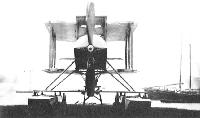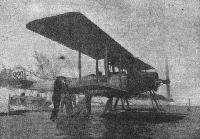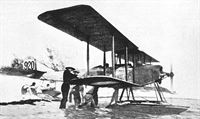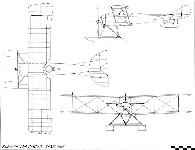
Описание
Страна: Великобритания
Год: 1914
Варианты
- Sopwith - Folder / Admiralty Type 807 Seaplane - 1914 - Великобритания
- Sopwith - Type 860 - 1914 - Великобритания
- H.King Sopwith Aircraft 1912-1920 (Putnam)
- M.Goodall, A.Tagg British Aircraft before the Great War (Schiffer)
- P.Lewis British Aircraft 1809-1914 (Putnam)
- J.Bruce British Aeroplanes 1914-1918 (Putnam)
- O.Thetford British Naval Aircraft since 1912 (Putnam)
- H.King Armament of British Aircraft (Putnam)
- Журнал Flight
-
J.Bruce - British Aeroplanes 1914-1918 /Putnam/
Designed for reconnaissance duties, the two-seat Sopwith Admiralty Type 807 seaplane emerged in 1914. Powered by a 100hp Gnome Monosoupape, the machine had a top level speed of 80mph at sea level. Serial no 807, seen here, was the first of these aircraft delivered to the RNAS, their serial nos being 807-810 and 919-926. Both 920 and 921 arrived in East Africa on 21 February 1915, where despite being adversely affected by the climate, they played a part in the ultimate destruction of the German cruiser, Konigsberg, on 11 July 1915.
-
H.King - Sopwith Aircraft 1912-1920 /Putnam/
Another aspect of Sopwith Folder No.807, showing not only the folded wings but the partly metal-sheathed propeller (for protection against water-damage).
-
Журнал - Flight за 1919 г.
The Sopwith tractor seaplane.
-
H.King - Sopwith Aircraft 1912-1920 /Putnam/
Folder No. 920 (nearest camera) shows distinct differences in wing cellule as compared with the preceding side view of No. 807.
-
Журнал - Flight за 1917 г.
A seaplane, in what was German East Africa, about to start a flight over the German cruiser "Konigsberg," for the purpose of "spotting" for artillery work.
-
J.Bruce - British Aeroplanes 1914-1918 /Putnam/
Sopwith 807 photographed at Niororo Island. The engine cowling has been removed to improve the cooling of the engine, and this aircraft has an enlarged fin.
In this view of Folder No.920 the uncowled engine (increasing cooling airflow and decreasing weight) is even more in evidence than the vertical tail surfaces, which differ from those seen in the side view of No.807. -
Журнал - Flight за 1917 г.
Another view of salving a seaplane after an accident.
-
P.Lewis - British Aircraft 1809-1914 /Putnam/
Sopwith 1914 Circuit Seaplane
H.King Sopwith Aircraft 1912-1920 (Putnam)
Folder Seaplane Type 807
In concluding the earlier chapter dealing with the 'Circuit Seaplanes' a special emphasis was placed on field of view this same consideration having led Short Brothers (who were Sopwith's chief rivals in the Naval-aircraft business) to prepare a more-or-less contemporary design for a tractor floatplane wherein the pilot and observer were seated almost entirely forward of the unstaggered wings. The engine in this Short aeroplane was to be mounted in the fuselage, in line with the wing trailing-edges, and driving the nose-mounted propeller by means of a shaft running beneath the two seats. The wings would fold, and, except for the special provisions just mentioned, the machine would have appeared to be similar in all essentials to the familiar Short 'Folders' that saw much service. The occupants were to have - for a tractor layout - a matchless field of view, especially for reconnaissance, defensive armament having been little considered (except in its theoretical and experimental aspects) until the coming of war.
Sopwith's partial solution to the field-of-view problem in their own 'Folder' seaplane, or Admiralty Type 807, was to place the observer under the centre-section leading-edge and the pilot under the trailing-edge. For the observer there was a small cutout; for the pilot a large one. Thus, although there was a general relationship between the 1914 Circuit Seaplane, the drawings marked 'D3' (to which allusion has been made in the context of that seaplane), and the Admiralty Type 807 now under study, the most significant development was folding wings.
Having already named Short Brothers as Sopwith's chief rivals in the Naval-aircraft business, it is fitting now to proclaim Short's undisputed leadership; and this can best be done by quoting what Oswald Short himself had to say many years before his death in 1969. Thus: 'My late brother, Horace, designed and built the first seaplanes with folding wings at Eastchurch in 1912. A patent was taken out for the invention. At a later date Mr. T. O. M. Sopwith wrote to me, saying he wanted to build an aeroplane with folding wings, and what royalty payments would we ask for. I replied ?15, and received a cheque for that amount. Strange as it may seem, that was the only sum Short Brothers ever received for that lasting invention from an aircraft constructor."
That the wings of the Sopwith Type 807 had no stagger - though its near-relation the 1914 Circuit Seaplane did incorporate this feature - is probably due to the wing-folding requirement; and this consideration, jointly with that for a good field of view, must have dominated the design. Though the Type 807 appeared in more than one version (or with relatively minor alterations) this fact is of secondary importance.
Twelve Sopwith Folders were built-in two batches, numbered respectively 807-810 and 919-926, the first aircraft being delivered in July 1914. All were constructed by Sopwith, and all initially had the 100 hp Gnome Monosoupape engine, installed in a Tabloid-like cowling. Clearly, these seaplanes were underpowered, especially when carrying bombs or wireless equipment in hot climates. More, indeed, is known concerning the operational performance of these aircraft than can be stated with confidence respecting their technical characteristics. The following facts, however, are relevant: Although - typically - the span was about 36 ft (11 m) both this measurement and the overall length may have varied quite widely. Recorded differences in span could well be accounted for by the extent of the very marked overhang on the outer portions of the upper wings, which were wire-braced not only to kingposts above, but to the lower wings also. Ailerons were fitted to the upper wings only, though it is certain that the lower wings were of at least two different spans. Length might have varied because of differences in tail design, two known forms whereof are confirmed. Engine installations likewise may well have varied, some cowlings being more bull-nosed than others or even removed altogether - as in the instance of No.920 when operating at Niororo Island in the Konigsberg affair (to improve cooling and save weight). Conversely, the floats were sometimes deliberately filled with water - though only when an aircraft was not in use - to keep them from warping in the heat.
Certainly the airframes - equally with the engines - were prone to get "under the weather". Take-off was generally poor (when it was possible at all, in a hot climate or a choppy sea), and the sprung floats of No.922 at least were criticised not only for their fragility, but for imparting 'bounce' at take-off. Rate of climb and ceiling were rendered in expletives rather than figures. And as though the take-off was not a sufficient problem, the airframe came 'unstuck' when not required to do so, the trouble here being the type of glue applied in England.
Although no guns were carried, bombs most certainly were seemingly on the float cross-bracing struts; and in this regard one may now enlarge on the well-known instance of one of the 'anti-Konigsberg' Sopwith Folders refusing, day after day, to leave the water with a full complement of crew and petrol-plus two 50 lb and four 16 lb bombs. Less understandable than the Sopwith's stubbornness in this instance is the fact that it should have been carrying 50 lb bombs at all, even though by early 1918 the Bomb. H.E.R.L., 50 lb . Mk.IV was apparently in current use, and a Mk.II pattern was evidently still being issued at about the time of the Armistice. Conceivably the bomb carried by the Sopwith Folder was an adaptation of a 50 lb lyddite-filled artillery shell, as used in the Boer War. In any case, the Mk.IV 50 lb bomb had a particular association with internal (vertical) stowage in the D.H.9 a much later aircraft than the Sopwith Folder, though fittings, described as a 'bomb band and lug", were available late in the war for horizontal stowage. A particular point is made of this fact because, whereas the early Sopwith seaplane may well have been the first aircraft to carry the 50 lb bomb operationally, then among (he last may well have been the Camel 2F.1s which raided the Tondern Zeppelin sheds in July 1918.
Whatever the facts concerning armament, were one asked to enumerate the truly significant events in the development of British Naval aviation, one would certainly include among them the delivery for our first 'custom-built' seaplane-carrier HMS Ark Royal (the description of the ship is, I think, a just one, though the craft had first been intended as a merchantman) of Sopwith Folders Nos.807, 808 and 922 - to Blyth, Northumberland. This was at about the time of Ark Royal's commissioning, in December 1914, and the pilots employed by Sopwith to check these aircraft out - after the machines had been assembled in dockside fish-packing sheds - were Harry Hawker and Ronald C. Kemp.
Caution having earlier been exercised in noting that 'Clearly, these seaplanes were underpowered’, that ‘the lower wings were of at least two different spans' and that 'engine installations may well have varied' (though meaning, in that connection, installations of the 100 hp Gnome Monosoupape) one final qualification may now be added; in at least one superficially similar Sopwith seaplane operated in the Dardanelles an installation could possibly have been made of a (presumably more powerful) water-cooled engine, this having a frontal radiator and thus giving the appearance of an unequal-span Type 860 - two examples of which type did, in fact, go to the Dardanelles - though having no underwing floats for lateral stability. Fin area certainly seems to have been greater than on either form of the 'Folder' (Admiralty Type 807) illustrated in this present chapter, and the 'superficially similar' machine just mentioned could indeed have been a form of the Type 860, for this, as later noted, had - initially at least - wings that were arranged to fold.
Although tabulation of data for the Folder Seaplane Type 807 would be futile, it is worth remarking that, while the type was serving in the Dardanelles (having been taken there in Ark Royal, which left Sheerness on 1 February, 1915) it was reported to have a fuel capacity for 4 1/2 hrs' flying 'when equipped for scouting only'. It was further reported that, although not fitted with a 'long distance wireless installation’ it could carry 'a light W/T transmitting set’. This set was 'effective up to 10 miles' and (it was added) 'works on a 700 foot wave which can be received by T.B.D.s' (torpedo-boat destroyers).
Описание:








